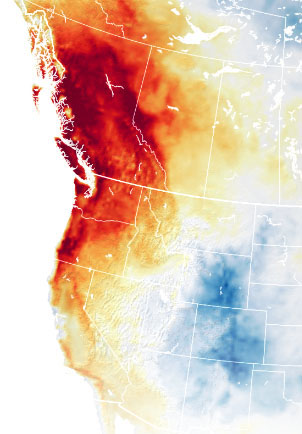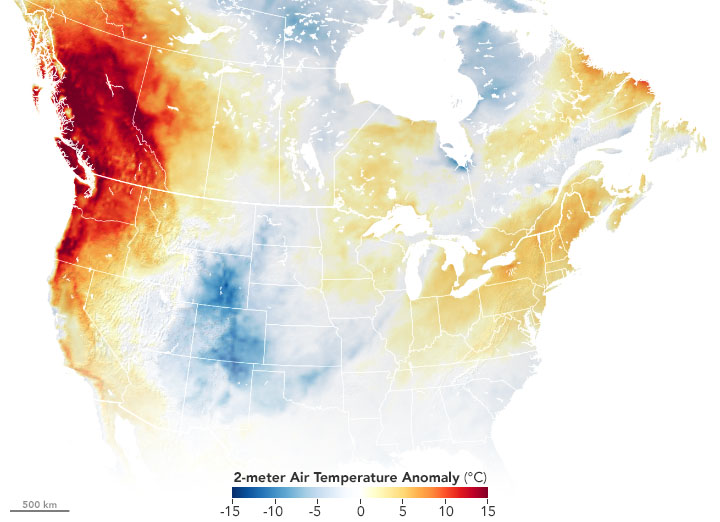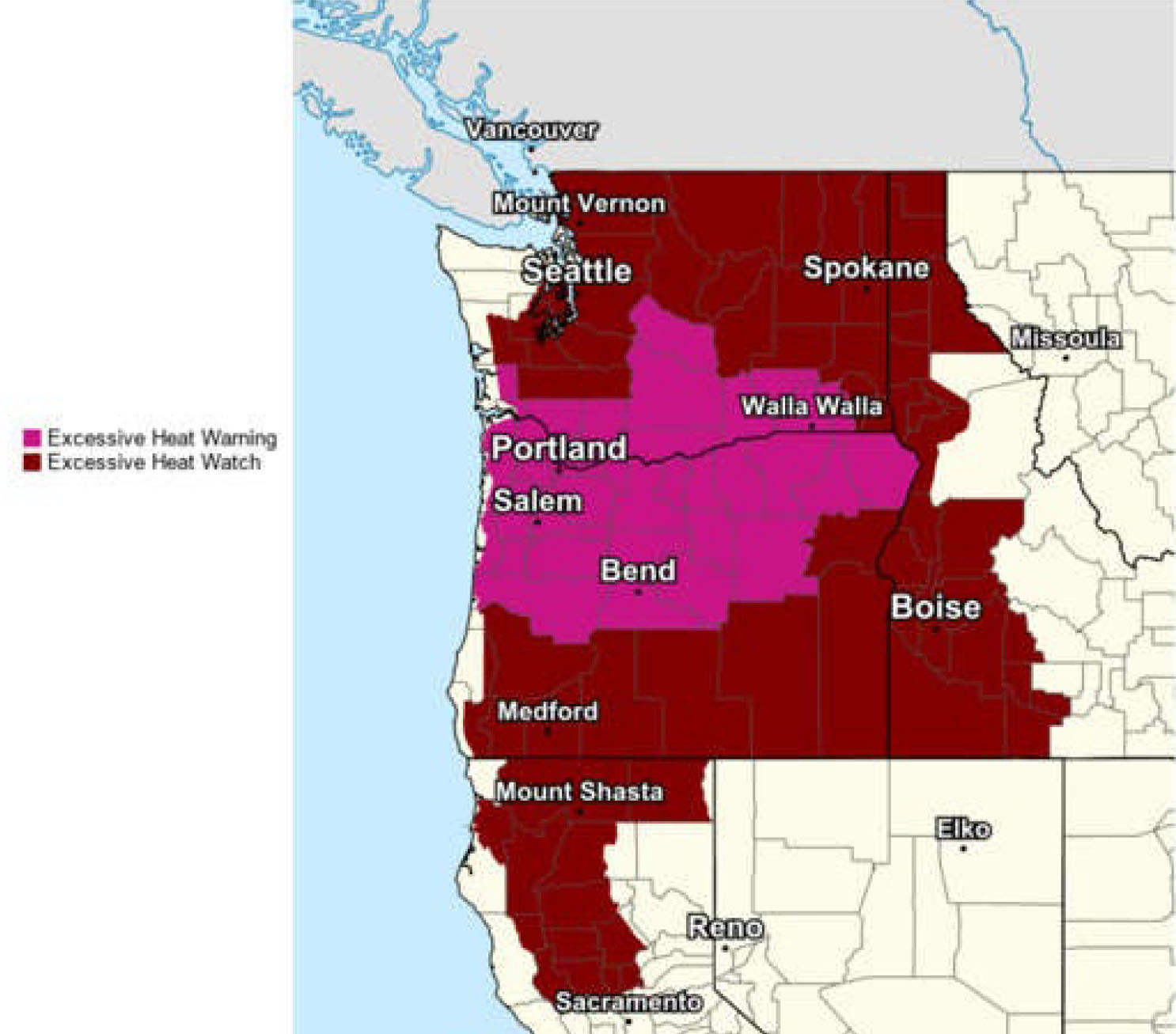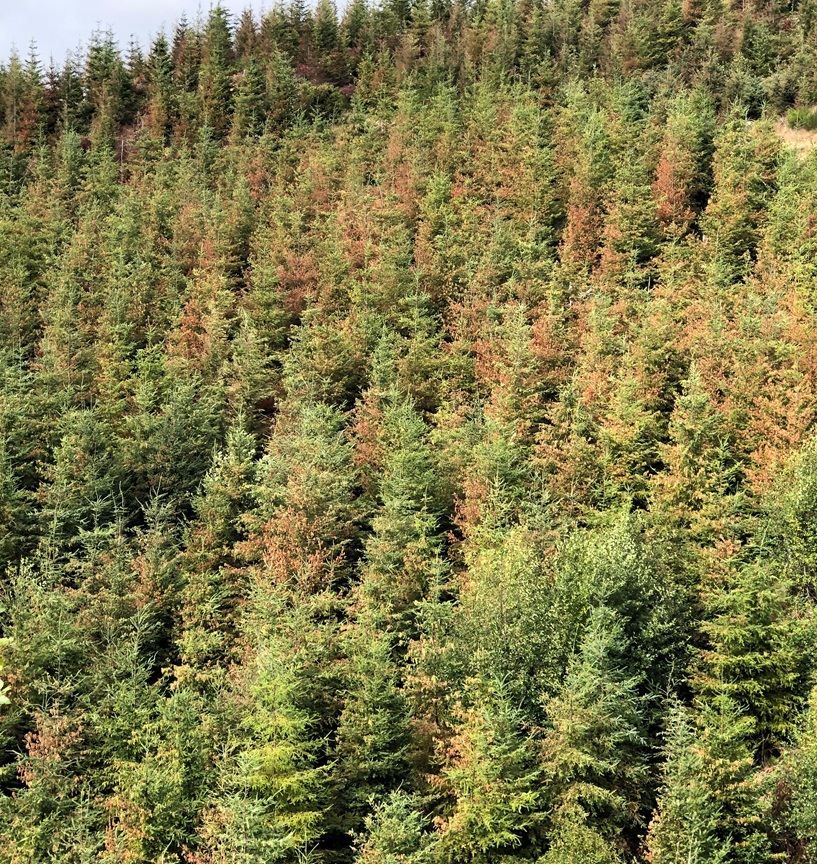A historic heatwave affected Oregon and the greater Pacific Northwest during late June 2021, breaking high temperature records, some by several degrees. On June 29, Oregon tied its official all-time record high of 119°F at the Pelton Dam COOP weather station in Jefferson County and at the Moody Farms Agrimet weather station in Wasco County. The previous official record was set in 1898, on July 28 at Prineville and on August 10 at Pendleton.
During the 2021 event, Portland International Airport exceeded 100°F for three consecutive days—108°F on June 26, 112°F on June 27, and 116°F on June 28. The previous record high at the airport was 107°F, making June 28 a remarkable nine degrees warmer. Similar temperatures were recorded throughout the Willamette Valley, with Salem Airport reaching 117°F on June 28. The temperature at the Pendleton Airport exceeded 100°F for five consecutive days, from June 26 through June 30. The Center for Health Statistics reported that 123 people died in Oregon because of the heatwave. Sixty-two people in Multnomah County alone were reported to have died because of hyperthermia.
The heat event became popularly known as the Heat Dome, a term that refers to a hot air mass that develops under a large area of high pressure in the upper part of the atmosphere and contributes to heatwaves. Oregon has experienced many such heat domes throughout history, although none in the modern instrumental record has resulted in weather nearly as hot as in June 2021. That event is more properly described as the 2021 Pacific Northwest heatwave. The term “heat dome” was recently added to the American Meteorological Glossary, possibly because it appeared so much in the media.
The 2021 heatwave was the result of an extremely unusual meteorological setup, with several factors contributing to the exceptionally hot temperatures. The primary meteorological driver was a large ridge of upper-level high pressure, which reached peak strength over southern British Columbia on June 27. Geopotential height at 500 millibars set new records over British Columbia and Washington (500 millibars is proportional to the temperature of the lower half of the atmosphere and is a common measure of the strength of a ridge of high pressure in the mid-troposphere). This indicates that the lower 6,000 meters or so of the atmosphere (about 20,000 feet) was exceptionally warm.
Because of atmospheric dynamics, air sinks under ridges of high pressure, which prevents clouds from forming and maximizes solar heating during the day. Air warms at a constant rate as it sinks, which causes further warming. During the 2021 Pacific Northwest heatwave, the position of the high pressure also inhibited cooler air from the Pacific Ocean from moderating temperatures everywhere except within a few miles of the coast. Furthermore, low-level winds over western Oregon at times blew from the east during the event, which caused the air to warm even more as it descended the Cascade Mountains into the Willamette Valley.
While extreme heat in Oregon historically has occurred later in the summer, the 2021 heatwave occurred near the summer solstice, which maximized the number of hours of solar heating and minimized the number of hours of nighttime cooling. It is possible that the unusually dry soil moisture across the region contributed marginally to the magnitude of the extreme heat, although it is uncertain by how much.
Nighttime temperatures were also warm throughout the event, which meant that people without air conditioning had no relief from the heat. This was especially true for urbanized areas and at higher elevations of the Willamette Valley, where nighttime temperatures remained higher than the relatively cool valley because of a nocturnal temperature inversion.
West of the Cascades, the heatwave ended abruptly during the afternoon and evening of June 28 when an onshore surge of cooler marine air displaced the heat in the lower atmosphere. That marine push resulted in rapid cooling, with temperatures dropping to the mid-60s by the morning of June 29, a dramatic decline of nearly 50°F.
It is virtually certain that human-caused global warming increased the magnitude of the heat in the June 2021 event, compared to an event in the absence of global warming. Oregon, like the rest of the world, has been getting warmer for decades as a result of increasing global concentrations of greenhouse gases. Summers at Portland International Airport (June, July, and August), for example, have warmed by over four degrees Fahrenheit since 1940, with much of that warming attributable to anthropogenic global warming.
Scientists are working to quantify the most likely contribution of anthropogenic climate warming to the 2021 heatwave. Some preliminary results suggest that anthropogenic warming increased the severity of the heat by roughly 2°F to 4°F. Because the heat event was so far outside the range of any heatwave observed over the region in the recorded past, it is difficult to assess how often such heatwaves can be expected to recur, but preliminary estimates are that it was a once-in-a-multimillennial event.
As the climate continues to warm, scientists believe that the likelihood of a heat event of similar magnitude, while still low, will progressively increase. In other words, as the background climate warms, it will not take exceptional meteorological conditions to result in extreme heat. The 2021 event was most likely enhanced by increases in temperature through human-caused climate change.
-
![]()
Map of temperature anomalies, higher or lower than average, during 2021 heat dome.
Courtesy U.S. Department of Agriculture, NASA Earth Observatory -
![]()
Heatwave damage on blackberries, 2021.
Courtesy Oregon State University, Bernadine Strik -
![]()
Map of temperature anomalies, higher or lower than average, during 2021 heat dome.
Courtesy U.S. Department of Agriculture, NASA Earth Observatory -
![]()
-
![]()
Tree scorch in Oregon caused by heat dome, 2021.
Courtesy Oregon State University, Gabriela Ritokova -
![]()
Memorial for Oregonians who died during the heat wave in 2021..
Courtesy City of Portland, Stephanie Yao Long
Related Entries
-
![Climate Change in Oregon]()
Climate Change in Oregon
Within a few hundred miles in Oregon, you can see snowy volcanoes, parc…
-
![Oregon Climate Change Research Institute]()
Oregon Climate Change Research Institute
The Oregon Climate Change Research Institute was established in 2007 to…
-
![Oregon Forests and Climate Change]()
Oregon Forests and Climate Change
How climate change affects Oregon forests and how those forests affect …
-
![Oregon Global Warming Commission]()
Oregon Global Warming Commission
The Oregon legislature created the Oregon Global Warming Commission in …
Map This on the Oregon History WayFinder
The Oregon History Wayfinder is an interactive map that identifies significant places, people, and events in Oregon history.
Further Reading
"June 2021 Heat Event Preliminary Findings and Action Steps." Multnomah County, 2021.
Heeter, Karen J. and Grant L. Harley, John T. Abatzoglou, KevinJ. Achukaitis, Edward R. Cook, Bethany L. Coulthard, Laura A. Dye, and Inga K. Homfeld. "Unprecedented 21st century heat across the Pacific Northwest of North America." npj Climate and Atmospheric Science vol. 6, no. 5 (2023).
Rojas, Cristina. "PSU Study: Everything Was Stronger In That Deadly June 2021 PNW Heatwave." Portland State University News. March 8, 2023.










